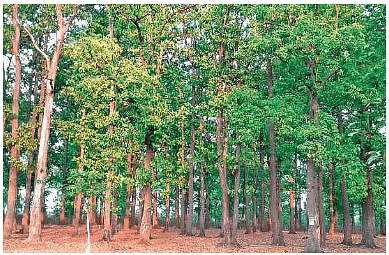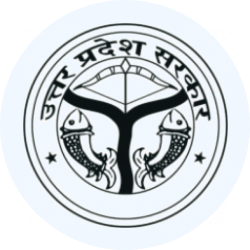UPPSC (UP) Exam > UPPSC (UP) Notes > Course for UPPSC Preparation > Uttar Pradesh: Vegetation - 1
Uttar Pradesh: Vegetation - 1 | Course for UPPSC Preparation - UPPSC (UP) PDF Download
Introduction
- By legal status, Reserved Forest constitutes 65.9%, Protected Forest 14.4% and Unclassed Forest 19.7% . There are three forest types, namely Tropical Moist Deciduous, Tropical Dry Deciduous and Tropical Thorn. Sal is an important forest formation of the State. Forests are distributed largely in the northern and partly in the southern parts of the State. The central part is devoid of forest vegetation as it is mainly under agriculture.
- A forest cover increase was recorded by the Forest Survey of India report of 1999, in the districts of Hardoi, Kheri, Saharanpur, because plantation was under taken 4-5 years earlier and also due to effective protection measures. A decrease in forest cover was observed in the districts of Banda, Jhansi, Mirzapur, and Sonbhadra which was largely on account of biotic pressures.
- Uttar Pradesh has been categorized into three major eco-zones on the basis of forest and vegetation types. These three zones are:- the Terai region; the Gangetic plains (West and East Uttar Pradesh); the Bundelkhand of Uttar Pradesh including the Vindhya ranges.
- The terai region of Uttar Pradesh is a very important ecosystem for many threatened species of tall wet grasslands and swamps and is the topmost priority for conservation . It supports many threatened bird species such as the Swamp Francolin Francolinus gularis and Bengal Florican Houbaropsis bengalensis . Earlier, the terai was continuous, but now it occurs in pockets in protected areas of India and Nepal such as the Royal Chitwan National Park (NP), Royal Bardia NP, Royal Parsa Wildlife Reserve and Royal Sukhlaphanta Wildlife Reserve in Nepal, and Karterniaghat Wildlife Sanctuary (WLS), Kishanpur WLS, and Dudwa NP in Uttar Pradesh and Valmiki WLS in Bihar.

- Reserved Forests (RF) A wasteland, forest area that is the property of government can be constituted as RF under the provision of the Indian Forest Act. Activities leading to damage to the forest are prohibited: clearing of forest; setting up of fire; kindling or carrying fire; causing damage to the trees, felling, girdling, logging, tapping, stripping of barks; quarrying of stones; poisoning of rivers; hunting of animals; trespassing of cattle and; cultivation
- Protected Forest (PF) The Indian Forest Act empowers the State government to declare any forest or wasteland, which is the property of the government or over which it has proprietary rights including the whole or any part of its forest produce, as PF. No act is prohibited unless notified.
- Forest and Wildlife Department Uttar Pradesh, conducts departmental tree plantation work during rainy season, to increase the forest and tree cover in the state various schemes are being implemented by the Uttar Pradesh government large scale tree plantation programme is being conducted in the state through social forestry, social forestry in urban areas, green belt development scheme and total forest cover scheme. The task of tree plantation is implemented by Forest and Wildlife Department in coordination with the other government departments. The efforts are being made to ensure ample participation of localities, women, farmers, public representatives and students in tree plantation programmes. The Forest and Wildlife Department and the state government are actively engaged to ensure the success of plantation work and high quality plantation.
- The various varieties of Rosewood, Neem, Cassia, Gulmohar, Jakranda, Cirrus, Kanji, Mango, Chitwan, Banyan, Pipal, Ficus, Mulsri, Bauhinia, Kadamb, Tamarind, Bel and Mahua are being planted in the state as per soil and climatic conditions. The state government is emphasizing on more and more plantation of large and conventional trees. The state government is making sustained efforts towards the establishments on green belt, development of eco tourism and success of plantations to increase the forests and tree cover in the state.
- In order to uplift living standard of communities living in forest areas and to include them in development and management of forests, the forestry works are being executed by constituting joint village forest management committees and eco development committees. In this way, efforts are being made to economically uplift the people living surrounding the forest areas by engaging them in wildlife protection and in forestry activities.
The document Uttar Pradesh: Vegetation - 1 | Course for UPPSC Preparation - UPPSC (UP) is a part of the UPPSC (UP) Course Course for UPPSC Preparation.
All you need of UPPSC (UP) at this link: UPPSC (UP)
|
117 videos|362 docs|105 tests
|
FAQs on Uttar Pradesh: Vegetation - 1 - Course for UPPSC Preparation - UPPSC (UP)
| 1. What is the significance of vegetation in Uttar Pradesh? |  |
Ans. Vegetation in Uttar Pradesh plays a crucial role in maintaining the ecological balance, providing habitats for various species, and contributing to the overall environmental well-being of the state. It also supports the agricultural sector by providing resources such as timber, fuelwood, and medicinal plants.
| 2. What are the major types of vegetation found in Uttar Pradesh? |  |
Ans. Uttar Pradesh is characterized by a diverse range of vegetation types. The major types include tropical dry deciduous forests, scrublands, grasslands, wetlands, and riverine vegetation. Each of these vegetation types has its own unique set of plant species and ecological significance.
| 3. How does the vegetation in Uttar Pradesh vary across different regions of the state? |  |
Ans. The vegetation in Uttar Pradesh varies across different regions due to variations in climate, topography, and soil conditions. The western and central parts of the state have predominantly dry deciduous forests, while the eastern parts have a mix of moist deciduous and wetland vegetation. The Himalayan region in the north supports a diverse range of alpine and sub-alpine vegetation.
| 4. What are the conservation efforts being undertaken to protect the vegetation in Uttar Pradesh? |  |
Ans. The Uttar Pradesh government has implemented several conservation measures to protect the state's vegetation. These include the establishment of wildlife sanctuaries, national parks, and protected areas to safeguard endangered plant species and their habitats. The government also promotes afforestation programs and encourages community participation in conservation efforts.
| 5. How does the vegetation in Uttar Pradesh contribute to the state's economy? |  |
Ans. The vegetation in Uttar Pradesh plays a vital role in the state's economy. It supports the agricultural sector by providing essential resources such as fodder, timber, and medicinal plants. The state's rich biodiversity also attracts tourists, contributing to the tourism industry. Additionally, the forest-based industries generate employment opportunities and contribute to revenue generation for the state.
Related Searches




















